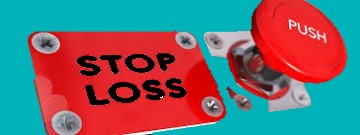
A stop-loss order is a type of order investors place with a broker/dealer in the market in advance. A computer automatically monitors the price of the underlying asset and triggers the order when the asset price breaches a predetermined level. At this time, the asset such as an ETF, mutual fund, stock, bond, FOREX or even cryptocurrency is sold automatically at the best available price. This price may not necessarily be the price or limit specified in the order. The order will attempt to sell the asset at the best available bid price at or below the specified order price once it is triggered. In a fast moving market, there may be fewer bids for an asset thus causing the asset to be sold at a price significantly lower than expected. This type of order may also be known as a “Stop-Order”, “Stop-Limit Order” or “Stop-market order”.
There is no restriction on the timing of this type of order. A stop-loss order is often placed as “GTC” meaning Good-Till-Cancelled. This means the order remains live in the market until cancelled by the investor. As the value of the underlying asset moves over time, the investor may however choose to modify the levels of the stop-loss order to reflect the change in asset value.
Why use a Stop-Loss Order?
The stop-loss order is used by traders and investors to reduce losses and risk exposure attributable to an underlying asset. The trader places the order with a broker at a level at which they no longer wish to own the asset. Most, if not all brokers, provide this functinality as part of their trading software. This level will not be so close to the current price that it will be triggered during the course of normal market fluctuations. At the same time, the order value should not be so far away from the current price so as to be ineffective in limiting potential losses. This value is therefore dependent on the traders attitude to risk and their unique investment style. Generally however, a stop-loss order is placed 10%-15% below the current price in normal market conditions.
Using a stop-loss order helps investors reinforce their trading discipline. The argument for using these types of orders suggest that should the price decline by this level, there must be something wrong with the asset. At which point, some investors may be tempted to stay invested. This is a problem for many investors who refuse to sell until they are “made whole” once again. That is, they have recouped all the losses incurred. However, as the asset experiences difficulties and the price declines further, this becomes an impossibility. Using a stop-loss order removes this situation by enforcing risk management discipline and exiting the position in the asset.
Stop-Loss Order Example
Let’s assume a trader buys shares of a company at $100 per share. The trader may then decide to enter a stop-loss order at $85. This order will automatically sell the stock and exit the long position should the stock fall 15% from its current level. This limits any potential further downside risk and the loss is capped at $15 per share. The rationale for using this risk management strategy is to protect the trader is the stock experiences a sudden bout of volatility and to enforce discipline when cutting losses. If the trader is unable to monitor the stock on a constant basis, this type of order can afford the investor the luxury of continuing to hold the positon without fear of catastrophic loss.
In addition to limiting losses and controlling risk, this type of order may also be used to lock in profits. Using the trailing stop-loss referred to earlier, the investor can move the level of the stop-loss upwards as the value of the underlying asset increases. If the asset price moves upwards and the stop-loss is not adjusted its use becomes redundant. By adjusting the level, the investor is able to bank potential profits and exit the position.
Criticism and Disadvantages
It is important traders understand the limitations and drawbacks of using a stop-loss methodology. There are occasions where this approach may not provide the level of protection that was anticipated when the original order was placed.
In our earlier example the investor bought stock at $100. Following the purchase, some negative news is announced such as the collapse of a acquisition proposal. The stock is expected to open sharply lower the next day. If the stop-loss order is set at $85 and the opening trade for the stock is $70, the order will be triggered. The order will be executed at the best available price which could be in the 60’s. It is unlikely there will be many bids until the situations becomes clearer. Many other traders may also be rushing to sell their stock creating fewer selling opportunities. In this instance, the order will not be filled anywhere near the level expected. To get around this issue, a stop-loss “limit order” can be used. Here, the sell order sits at the price specified, in this case $85 until it is filled. The risk of course is that the stock continues to decline and the order is not completed.
Short term fluctuations may also shake the investor out of the market, only to see the stock rally back immediately afterwards. This is the opposite of trend or channel investing where traders buy on the dips, or troughs within a noticeable trend and sell at the peaks. This demonstrates how investors should pay special attention to the level used in the stop-loss order. Investors should fully understand why it is necessary and what is expected of this type of order within their own unique situation.
